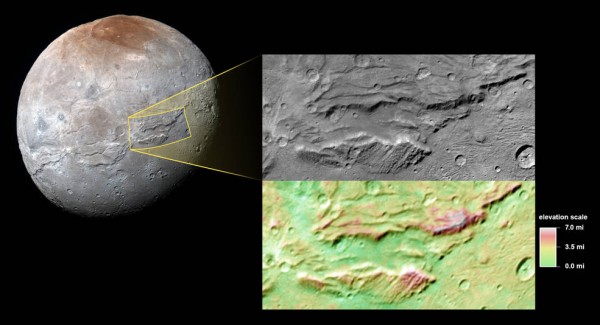By Ana Verayo, | February 21, 2016

A close-up of the canyons on Charon, Pluto's big moon, taken by New Horizons during its close approach to the Pluto system last July.
Charon, Pluto's largest moon was apparently home to a very ancient ocean.
High resolution images from NASA's New Horizons spacecraft during its closest approach to Pluto last July suggest how Charon once possessed a subsurface ocean that froze over that led to expanding outwards, as the lunar surface stretched out.
Like Us on Facebook
New Horizons provided first ever views of the mysterious, dwarf planet along with its moons when it arrived in 2015 as new images transmitted from the probe reveal how Charon acquired its unique surface terrain.
In this newly released image from NASA, mission scientists have determined an important region in Charon, spanning 1,100 miles that is known as Serenity Chasma. The moon's surface also revealed chasms that measure 4.5 miles deep into its interior. Charon possesses a diameter of 1,440 miles making Serenity Chasma appearing like Earth's Grand Canyon that ripped through the moon's surface. Compared to the Grand Canyon, which is only 277 miles long and only around a mile deep, Serenity Chasma almost covers the entire moon.
According to NASA officials, the lower region of the image is identified with topography that has been color coded indicating the same scene or terrain. Data obtained from the new images reveal how the water ice layer on Charon could have been flowing liquid in part during its past, but now, has returned to its refrozen state.
Captured by New Horizons' Long-Range Reconnaissance Imager (LORRI) from a distance of 48,900 miles from the surface of Charon, during the July flyby, scientists also say that this specific distance is about one hour and 40 minutes before New Horizon's closest rendezvous with Pluto's biggest moon last July 14.
According to the New Horizons team, Pluto's moons could have been formed during the collision of the dwarf planet with other objects from the Kuiper Belt. Charon's outer layer composition is mostly made of water ice as this layer is heated up by the moon's core due to radioactive elements during its early formation.
Scientists believe that this heat triggered the outer layer's ice to melt into flowing liquid that later seeped through the outer layer, creating this subsurface ocean underneath the moon. When Charon cooled down, the liquid layer also freezed and since water expands in its frozen state, the layer caused the outer layer to fracture, thus forming multiple chasms across the surface of Charon.
To date, New Horizons is now transmitting a deluge of data including high resolution images from its Pluto flyby at a rate of one to four kilobytes per second, which will be completed towards the end of this year.
-
Use of Coronavirus Pandemic Drones Raises Privacy Concerns: Drones Spread Fear, Local Officials Say

-
Coronavirus Hampers The Delivery Of Lockheed Martin F-35 Stealth Fighters For 2020

-
Instagram Speeds Up Plans to Add Account Memorialization Feature Due to COVID-19 Deaths

-
NASA: Perseverance Plans to Bring 'Mars Rock' to Earth in 2031

-
600 Dead And 3,000 In The Hospital as Iranians Believed Drinking High-Concentrations of Alcohol Can Cure The Coronavirus

-
600 Dead And 3,000 In The Hospital as Iranians Believed Drinking High-Concentrations of Alcohol Can Cure The Coronavirus

-
COVID-19: Doctors, Nurses Use Virtual Reality to Learn New Skills in Treating Coronavirus Patients







